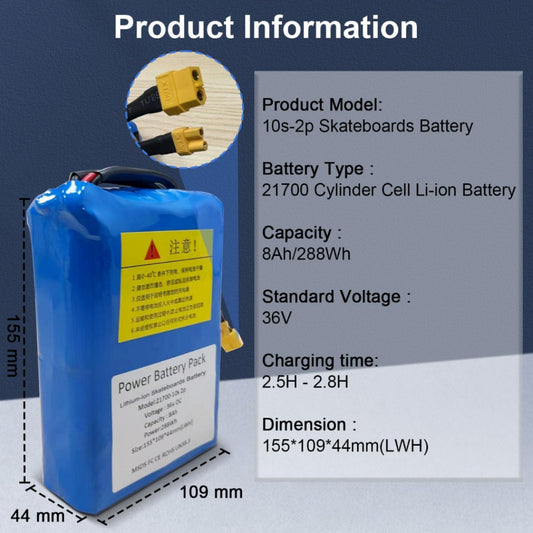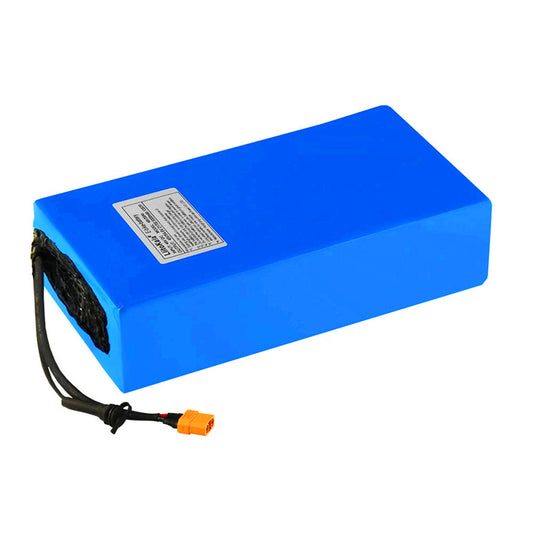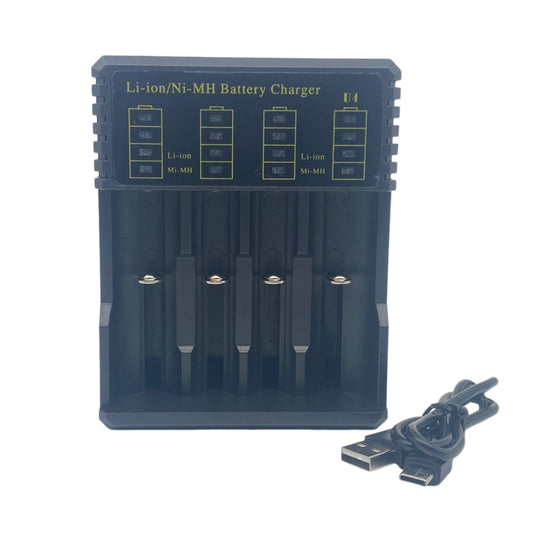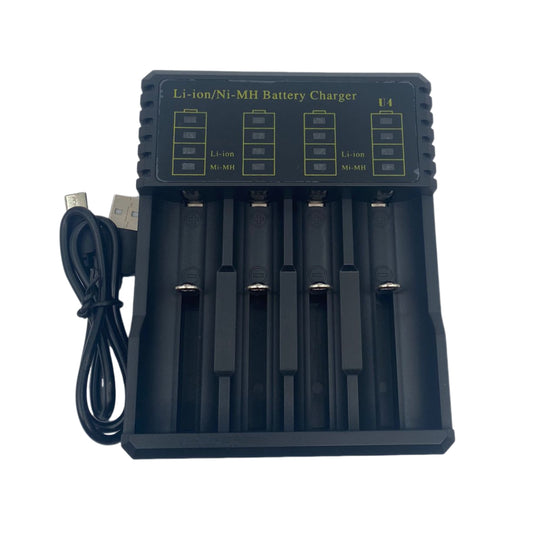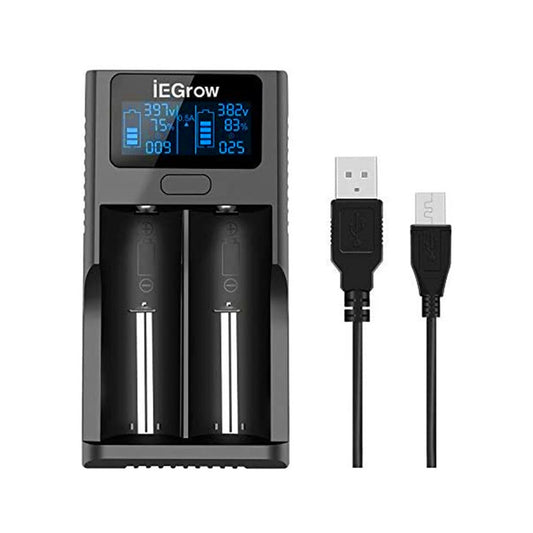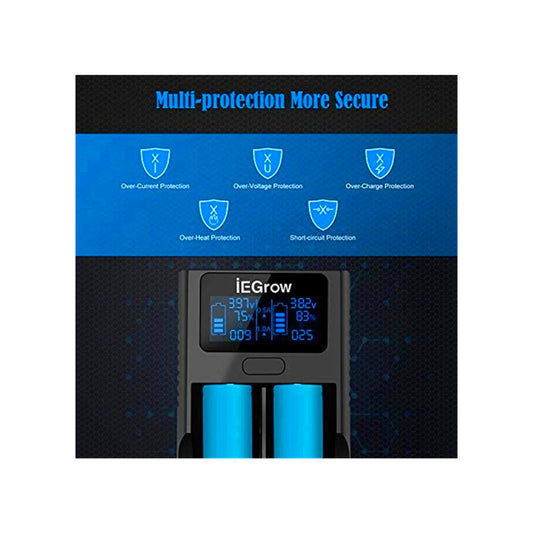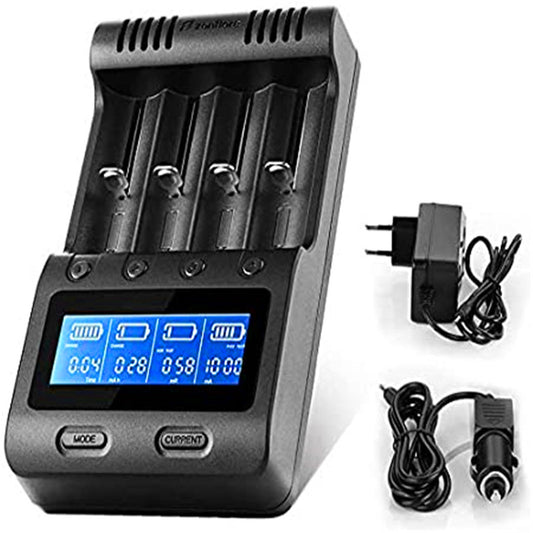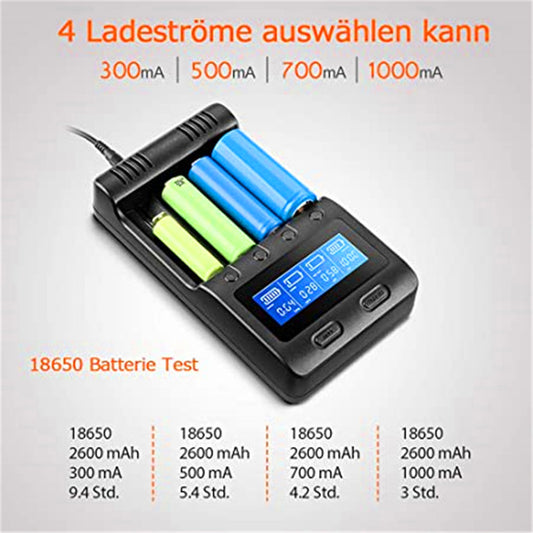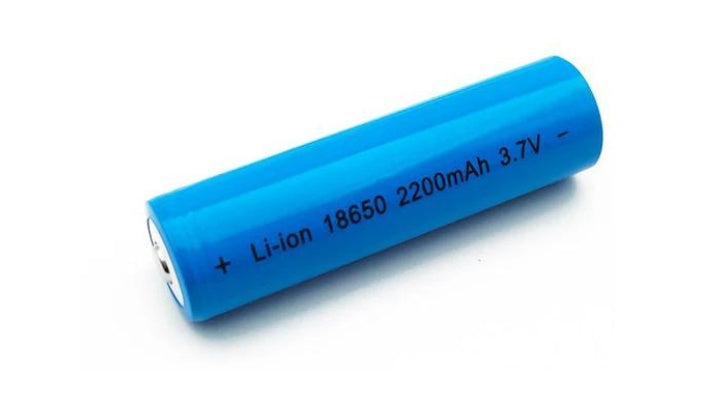The 18650 battery is a widely used lithium-ion cell known for its cylindrical shape and versatility in various applications. These 18650 batteries have the advantages of being lightweight and high capacity. This article mainly introduces the normal 18650 voltage range, how to measure it, and its common problems.
What Is the Voltage Range of 18650 Batteries?
18650 batteries have a specific operating voltage range (2.5 volts to 4.2 volts). This varies depending on the state of charge:-
Fully Charged Voltage: At full charge, an 18650 battery usually reaches up to 4.2 volts. This upper limit is where the battery holds its maximum capacity.
-
Nominal Voltage: Typically, the regular working voltage of an 18650 battery is cited as 3.7 volts. This is the average voltage at which the battery operates during normal use.
- Minimum Voltage Threshold: When the battery is depleted, its voltage drops to about 2.5 volts. It's crucial not to allow the battery to discharge below this point to avoid damaging the battery's internal structure and chemistry.
Operating within these voltage parameters ensures the battery's longevity and safety, preventing overcharging and deep discharging, which can adversely affect the battery's health and performance.
Are all 18650 batteries the same voltage?
No, not all 18650 batteries have the same voltage. While they typically share common voltage thresholds—such as a full charge voltage of around 4.2 volts and a nominal voltage of 3.7 volts—their specific voltage can vary slightly based on the battery chemistry and manufacturer specifications:
-
Lithium-ion (Li-ion) batteries generally have a full charge voltage of about 4.2 volts and a nominal voltage of 3.7 volts.
-
Lithium iron phosphate (LiFePO4) batteries have a lower full charge voltage of about 3.6 volts and a nominal voltage of around 3.2 volts.
- Lithium manganese oxide (LiMn2O4) and other variations may also have different voltages.
The specific design and intended application can influence the voltage parameters of an 18650 battery, making it important to check the manufacturer's specifications to ensure compatibility with your device.

How to Measure 18650 Battery Voltage?
To accurately measure the voltage of an 18650 battery using a multimeter, follow these instructions:
-
Initial Preparations: Ensure the device is switched off before removing the 18650 battery to prevent any electrical hazards. Gather your tools: a multimeter, a battery holder, and clips to secure the battery if available.
-
Setting the Multimeter: Adjust your multimeter to the DC voltage mode, indicated by a "V" symbol with a straight and dotted line beneath it. This setting measures the direct current voltage suitable for lithium-ion batteries.
-
Connecting the Multimeter Probes: Attach the red probe to the positive (+) terminal of the battery, and the black probe to the negative (-) terminal. Make sure the connections are firm to get an accurate reading.
-
Taking the Voltage Reading: Look at the multimeter display to see the voltage. A fully charged 18650 battery will typically show about 4.2 volts, whereas a normally charged one will read around 3.7 volts. Monitoring these levels helps gauge the battery's condition.
-
Assessing Battery Condition: A voltage reading at or below 2.5 volts indicates a deeply discharged state, which is harmful to lithium-ion batteries and may suggest damage or degraded performance.
-
Ensuring Safe Measurement: Be careful to prevent the multimeter probes from touching each other or connecting both to one terminal simultaneously, as this can create a short circuit, risking damage to both the multimeter and the battery.
This method provides a comprehensive approach to determining the voltage of 18650 batteries. Regular measurement of 18650 battery voltage helps to maintain battery efficiency and life.
Why Does the Voltage of the 18650 Battery Change When Charging and Discharging?
The voltage change in an 18650 lithium-ion battery during charging and discharging can be explained by the underlying electrochemical processes and how they are influenced by various factors:
-
Electrochemical Process: At the core of an 18650 battery's operation are the lithium ions that shuttle between the anode (typically made of graphite) and the cathode (commonly a lithium metal oxide).
During discharging, these ions move from the anode to the cathode through the electrolyte. When charging, an external power source drives the ions back to the anode, increasing the anode's lithium concentration and the battery’s voltage. -
Internal Resistance: During high discharge rates, this resistance can lead to significant voltage drops. Conversely, during rapid charging, resistance can cause a temporary increase in voltage, which should be carefully managed to avoid damaging the battery.
-
State of Charge and Depth of Discharge: The state of charge (SOC) of a battery, which indicates the remaining capacity, is closely linked to its voltage. A higher SOC corresponds to a higher voltage. The depth of discharge (DOD), which refers to how much of the battery's capacity has been used, inversely affects the voltage: deeper discharges result in lower voltages.
Proper charging practices and avoiding deep discharges, can significantly impact the effective life and efficiency of an 18650 lithium-ion battery.
What factors can affect the battery voltage?
Several factors can affect the voltage of a battery, influencing its performance and longevity. Here are the key factors:
-
State of Charge (SoC)
This is the most direct factor affecting battery voltage. The relationship between SoC and voltage can help determine how much energy remains in the battery.
-
Temperature
Battery performance is highly temperature-dependent. Cold temperatures can reduce the battery's ability to deliver power, leading to a lower voltage output, while high temperatures might increase the voltage temporarily. However, excessive heat can accelerate battery degradation, ultimately affecting long-term voltage stability.
-
Battery Age and Health
As batteries age, they undergo physical and chemical changes such as electrode material degradation and the buildup of internal resistance. These changes reduce the battery's capacity and can cause a lower voltage output compared to a new battery.
-
Battery Chemistry
Different types of batteries, such as lithium-ion, lead-acid, or nickel-metal hydride, have different nominal voltages and behaviors under various conditions.
-
Environmental Conditions
External factors like humidity and pressure can also influence battery performance. For instance, high humidity levels can lead to corrosion of battery contacts, increasing resistance and affecting voltage.
-
Cycle Count
The number of charge-discharge cycles a battery undergoes affects its overall health. Frequent cycling, especially deep cycling (fully discharging and charging a battery), can wear out a battery faster, decreasing its ability to hold a charge and maintain a stable voltage.
Understanding these factors is beneficial for maximizing battery efficiency, extending its lifespan, and ensuring safe operation within its designed parameters.
What Is the Relationship Between 18650 Battery Voltage and Soc?
The relationship between the voltage of an 18650 battery and its State of Charge (SoC) is a crucial aspect of battery management and performance. Here’s a detailed explanation of this relationship:
-
Voltage as an Indicator: The voltage of an 18650 battery changes in a predictable pattern based on its SoC. As the battery discharges and the SoC decreases, the voltage also drops. Conversely, as the battery charges and the SoC increases, the voltage rises.
- Voltage Ranges and SoC Levels: Typically, a fully charged 18650 battery at 100% SoC will have a voltage of around 4.2 volts. As the battery discharges, the voltage decreases; at around 50% SoC, the voltage might be approximately 3.7 volts, which is considered the nominal voltage. When the battery reaches a critically low SoC, such as 0-5%, the voltage might fall to about 2.5 volts or lower, signaling that the battery is nearly depleted.

For example, if a battery is not to be used for an extended period, it is recommended that it be charged to approximately 50 percent SOC rather than stored fully charged. Prolonged storage at high SOC will accelerate the natural degradation of the battery.
How to prevent the 18650 battery voltage from exceeding the normal range?
Preventing an 18650 lithium-ion battery's voltage from exceeding its normal range can maintain battery health and safety. Here are several strategies to ensure the voltage remains within safe limits:
-
Use a Compatible Charger
Always use a charger that is specifically designed for lithium-ion batteries. The charger should have an appropriate voltage limit setting of 4.2 volts per cell to prevent overcharging.
-
Regular Monitoring
Regularly check the battery’s voltage using a multimeter or a battery management system (BMS). This is especially important during charging and discharging to ensure the voltage does not go beyond the typical range of 2.5 to 4.2 volts.
-
Temperature Control
Maintain the battery in a moderate temperature environment. Extreme temperatures can affect battery chemistry and might lead to higher voltages or even thermal runaway.
-
Balanced Charging and Usage
Using a balanced charger for batteries that are part of a pack, such as the 21700 battery pack and 18650 battery pack, can ensure each cell is equally charged. This prevents any single cell from overcharging, which can lead to voltage spikes.
-
Quality Battery and Charger
Buy high-quality batteries and chargers from reputable battery manufacturers. Quality products typically have better manufacturing standards and built-in safety features that reduce the risk of voltage irregularities.
-
Avoid Fast Charging When Possible
Fast charging can sometimes push the voltage to the upper limit quickly, leaving less margin for error and increasing the risk of overcharging. Unless necessary, opt for a slower charging rate to ensure a more stable charge cycle.
-
Discharge Rate
Be cautious about the discharge rate; high discharge rates can sometimes cause a significant drop in voltage and subsequent rebound that might harm the battery.
By implementing these practices, you can significantly reduce the risk of your 18650 batteries' voltage exceeding the normal range, thereby enhancing their longevity and safety.
Related article: 18650 Battery Vs AA
How Long Does a Ring Doorbell Battery Last?
In Conclusion
The 18650 battery voltage not only indicates the battery's charge level but also affects its capacity, power delivery, and overall efficiency. Proper management of voltage through appropriate charging, discharging, and storage practices is very useful for maintaining battery health and safety.
FAQs
1. What is the optimum storage voltage for 18650 batteries?
The optimum storage voltage for 18650 lithium-ion batteries, when not in use for extended periods, is typically around 3.6 to 3.8 volts per cell. This voltage level represents approximately 40% to 60% of the total charge capacity of the battery. Storing batteries at this state of charge will help minimize the rate of degradation and extend the overall life of the cells.
It's advisable to check the batteries regularly during storage and keep them within this optimum voltage range to ensure they remain healthy and retain their charge capacity effectively.
2. What is the voltage of a bad 18650 battery?
A "bad" 18650 lithium-ion battery can exhibit various issues indicated by its voltage behavior. If the battery consistently shows a voltage significantly below 2.5 volts, rapidly drops in voltage under load, fails to reach a full charge of about 4.2 volts, or displays erratic voltage fluctuations, it may be damaged or degraded.
These symptoms suggest internal problems such as increased resistance, reduced capacity, or physical damage, indicating that the battery is no longer effective and should be replaced while ensuring proper disposal according to safety regulations.
3. Can an 18650 3.7V lithium-ion battery use a 4.2V charger?
Yes, an 18650 3.7V lithium-ion battery can use a 4.2V charger because 4.2 volts is the standard charging voltage for most lithium-ion batteries when they are fully charged. The nominal voltage of these batteries, which is typically listed as 3.7V, refers to their average or operating voltage during use, not the charging voltage.
While using a 4.2V charger is technically correct, it's crucial to ensure that the charger also has proper safety features to prevent overcharging. A good lithium-ion battery charger will stop charging once the voltage per cell reaches 4.2V and will monitor the temperature and charging rate to prevent any potential hazards.
4. Do 18650 and 21700 batteries have the same voltage?
The 18650 and 21700 batteries typically have the same voltage characteristics but differ in size and capacity. Both types of batteries are lithium-ion cells and usually have the same nominal voltage and charging voltage: -
Nominal Voltage: Both 18650 and 21700 batteries generally have a nominal voltage of 3.7 volts, which is the standard for most lithium-ion cells.
- Charging Voltage: The charging voltage for both types of batteries is also typically the same, around 4.2 volts when fully charged.
-
Size: The 18650 battery has dimensions of 18mm in diameter and 65mm in length. The 21700 battery is larger, with a diameter of 21mm and a length of 70mm.
- Capacity: Due to its larger size, the 21700 battery usually offers a higher capacity, meaning it can store more energy than the 18650 battery. This translates to longer usage time per charge depending on the application.



